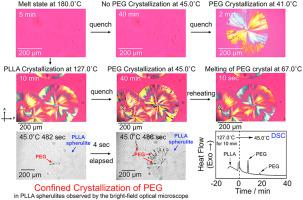Polymer ( IF 4.1 ) Pub Date : 2021-01-04 , DOI: 10.1016/j.polymer.2020.123370 Apisit Banpean , Shinichi Sakurai

|
The intriguing crystallization behavior of poly(ethylene glycol) (PEG) in a blend specimen of PEG with poly(L-lactic acid) (PLLA) was studied by polarized optical microscopy (POM) and differential scanning calorimetry (DSC). The PLLA/PEG (50/50) blend specimen was heated up to 180.0 °C and kept at this temperature for 5 min to obtain a complete melt without liquid-liquid phase separation. Then, a two-step temperature-jump was conducted as 180.0 °C→ 127.0 °C→ 45.0 °C. For this particular condition, it was found that PEG can crystallize only in the preformed spherulites of PLLA, as no crystallization of PEG was found in the matrix of the mixed PLLA/PEG amorphous phase. This is because of the depression of the freezing temperature (Tf) of PEG in the complete mixture of the PLLA/PEG (50/50) blend specimen by noting that Tf for the neat PEG specimen is 52.0 °C. Upon the PLLA crystallization at 127.0 °C, the PEG content in the amorphous region inside the PLLA spherulite was increased because of the formation of the pure solid phase of PLLA (crystalline phase). Namely, the PLLA content was decreased in the amorphous phase of the PLLA/PEG mixture. Then, Tf of PEG increased so that PEG could crystallize but this crystallization was only allowed inside the PLLA spherulite. Thus, the confined crystallization of PEG can be accounted for. It was further found that the ultimate degree of crystallinity () of PEG was increased and the induction period of the confined crystallization of PEG was decreased with an increase in the PLLA crystallization time at 127.0 °C. This is simply because the PEG content in the amorphous phase was increased due to the increase in the PLLA amount crystallized, which was more clearly recognized as a function of the size of the preformed PLLA spherulite. The direct evidence of the PEG crystallization was obtained by the wide-angle X-ray scattering. The kinetics was also studied for the confined crystallization of PEG. Based on the results of the kinetic study, the effect of the space confinement will be discussed.
中文翻译:

在PLLA / PEG共混物中的聚(L-乳酸)球晶中聚(乙二醇)的受限结晶
通过偏振光学显微镜(POM)和差示扫描量热法(DSC)研究了聚乙二醇(PEG)与聚(L-乳酸)(PLLA)的共混样品中有趣的结晶行为。将PLLA / PEG(50/50)共混样品加热到180.0°C,并在此温度下保持5分钟,以得到完全的熔融,而没有液-液相分离。然后,进行两步的温度跳跃:180.0℃→127.0℃→45.0℃。对于该特定条件,发现PEG只能在预先形成的PLLA球晶中结晶,因为在混合的PLLA / PEG无定形相的基质中未发现PEG的结晶。这是因为冷冻温度(T f)在PLLA / PEG(50/50)混合样品的完全混合物中加入PEG,注意纯PEG样品的T f为52.0°C。在127.0°C下PLLA结晶后,由于形成了PLLA纯固相(结晶相),因此PLLA球晶内部非晶区的PEG含量增加。即,PLLA / PEG混合物的非晶相中的PLLA含量降低。然后,PEG的T f增加,使得PEG可以结晶,但是该结晶仅允许在PLLA球晶内部。因此,可以解释PEG的受限结晶。进一步发现,最终结晶度(随着127.0°C下PLLA结晶时间的增加,PEG的)增加而PEG的受限结晶的诱导期减少。这仅仅是因为非晶态相中的PEG含量由于结晶的PLLA量的增加而增加,这更清楚地认识到它是预制PLLA球晶尺寸的函数。PEG结晶的直接证据是通过广角X射线散射获得的。还研究了PEG的有限结晶的动力学。根据动力学研究的结果,将讨论空间限制的效果。











































 京公网安备 11010802027423号
京公网安备 11010802027423号